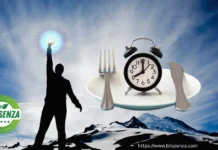Picture this: you’ve just finished a big lunch—maybe a plate of pasta with a sugary soda—and 20 minutes later, you’re struggling to keep your eyes open. You might think, “Oh, I just need a quick nap,” but here’s the truth: that’s not normal.
Feeling sleepy so soon after eating can signal something’s off with your body. Experts call this postprandial somnolence, a fancy term for that drowsy feeling after a meal, this happens when your body struggles to handle what you ate, leaving you tired instead of energized.
In this article, we’ll break down why this happens, what’s going on inside your body, and share simple, natural fixes to keep your energy steady all day.
What’s Happening in Your Body? The Science Made Simple
When you feel like napping just 20 minutes after eating, three main culprits are likely at play: blood sugar dysregulation, poor digestion, and metabolic overload. Let’s unpack each one in plain terms.
- Blood Sugar Dysregulation: Your blood sugar—the energy your body gets from food—spikes and crashes quickly after eating certain foods, especially those high in carbs or sugars. Imagine eating a big bowl of white rice or a sugary dessert like a chocolate bar. These foods break down fast, flooding your blood with sugar. Your body pumps out insulin—a hormone that helps store sugar—to handle the spike, but it often overdoes it, causing a sharp drop, this drop leaves you feeling tired and foggy.
- Poor Digestion: If your meal is heavy or hard to break down—like a greasy burger with fries—your stomach has to work overtime. This pulls energy away from the rest of your body, making you feel sluggish as your system focuses on digestion.
- Metabolic Overload: Eating too much at once, especially processed foods, overwhelms your metabolism—the process your body uses to turn food into energy. It’s like trying to run a car engine on low-quality fuel; it sputters and stalls, leaving you drained.
This sleepy feeling, or postprandial somnolence, often hits when you eat meals loaded with refined carbs (like white bread or pasta) or sugars (like soda or candy). But don’t worry—there are easy ways to fix this and feel energized instead!
Why Does This Happen More with Certain Foods?
Not all foods cause this sleepy slump, the main troublemakers are refined carbohydrates and sugary foods, here’s why:
- Refined Carbs: Foods like white bread, white rice, white flour or sugary cereal are stripped of fiber and nutrients during processing. They digest quickly, causing a fast blood sugar spike and crash. For example, eating a bagel for breakfast might leave you yawning by mid-morning.
- Sugary Foods and Drinks: A can of soda or a piece of cake gives you a quick sugar rush, but it’s followed by a steep drop. Your body isn’t built for these rapid swings, our food was never meant to be so processed and artificial—so you end up feeling tired instead of refreshed.
Compare that to a meal with whole foods like grilled chicken, eggs, nuts etc. These digest more slowly, keeping your blood sugar steady and your energy up. Let’s look at how to make better choices to avoid this crash.
How to Fix Post-Meal Drowsiness: Simple, Natural Steps
The good news? You can take control and stop feeling sleepy after meals with a few easy changes. Here’s how to do it, step by step:
1. Start with the Protein on Every Meal
Eating protein at the beginning of your meal helps slow down digestion and keeps your blood sugar steady instead of a spike and crash. At Blissenza, we prefer animal-based proteins for a low-carb boost, but you can choose what works for you!
- Examples: Start lunch with a piece of grilled chicken, a boiled egg, or a handful of chickpeas if you’re okay with plant-based options. For a snack, try smoked salmon or turkey slices, or even a few pumpkin seeds if you prefer. For breakfast, kick off with scrambled eggs with butter and bacon—or a handful of almonds if you’re not eating meat, you can also try Greek yogurt with a few nuts before adding fruit.
- Why It Works: Protein digests slowly, balancing insulin and keeping you full without the carb crash. Animal-based options are our go-to for natural, unprocessed energy!
2. Skip Sugary Drinks
Sugary drinks like soda, sweetened iced tea or energy drinks, are a fast track to a blood sugar crash. They’re packed with sugar that hits your system all at once, causing that sleepy slump.
- Examples: Swap out soda for water, herbal tea, or sparkling water with a splash of lemon. If you crave something sweet, try a small piece of fruit like an orange, it has natural sugar plus fiber to slow absorption.
- Why It Works: Cutting sugary drinks reduces those quick sugar spikes, helping your body maintain steady energy. Plus, staying hydrated with water supports better digestion.
3. Walk for 5-10 Minutes After Eating
A short walk after your meal can work wonders. It gets your blood moving, helps your body process the food, and prevents that heavy, tired feeling.
- Examples: After lunch, take a quick stroll around your block or even pace around your living room while chatting on the phone. If you’re at work, walk to a coworker’s desk instead of calling or texting.
- Why It Works: Walking boosts circulation, helping your body move sugar into your cells for energy instead of letting it pool in your blood. It also aids digestion by gently stimulating your stomach and intestines.
Extra Tips to Keep Your Energy Steady
Beyond these three steps, here are a few more habits to help you avoid post-meal drowsiness and feel your best:
- Add Fiber to Your Meals: Add low-carb veggies like spinach, broccoli, or cauliflower to your meals. For example, a plate of grilled steak with sautéed kale is a perfect animal-based, fiber-rich combo, or try a spinach salad with hard-boiled eggs if you’re keeping it lighter.
- Eat Smaller, Balanced Meals: Big meals can overwhelm your system. Instead of a giant plate of pasta, have a small portion with a side of veggies and a bigger portion of protein, like shrimp and chicken stir-fry with zucchini and bell peppers.
- Watch Your Timing: Eating too late at night can mess with your sleep and digestion, making you feel tired the next day. Aim to finish dinner at least 2-3 hours before bed.
Real-Life Example: A Day Without the Slump
Let’s see how this looks in action. Imagine your typical lunch is a fast-food burger, fries, and a soda, by 1:00 PM, you’re yawning at your desk. Now, try this instead:
- Lunch: Start with a piece of grilled chicken (protein-first), then add a side of steamed broccoli (fiber), and finish with a side of buttered asparagus.
- Drink water with a slice of lemon instead of soda.
- After Eating: Take a 5-minute walk around your office or step outside for some fresh air.
By 1:00 PM, you’ll likely feel alert and ready to tackle your afternoon—no nap needed! These small changes can make a big difference in how you feel.
Why This Matters for Your Long-Term Health
Postprandial somnolence isn’t just about feeling tired, it’s a sign your body is struggling. Over time, frequent blood sugar spikes and crashes from high-carb diets can increase your risk of bigger problems like insulin resistance, type 2 diabetes, and weight gain (1)(2).
Poor digestion can also lead to bloating, discomfort, and nutrient deficiencies. By making these simple tweaks, you’re not just avoiding a nap, you’re protecting your health for the long haul.
At Blissenza, we’re all about empowering you with natural solutions that work with your body, not against it. These steps are a great starting point to take control of your energy and feel your best every day.
When to Talk to a Doctor
If you try these tips and still feel overly sleepy after meals, or if you notice other symptoms like dizziness or extreme fatigue, or stomach pain, it’s worth checking in with a doctor, it could be a sign of low blood sugar (hypoglycemia), or even a thyroid problem.
Conclusion: Take Charge of Your Energy Today
Feeling sleepy after eating doesn’t have to be your norm, by understanding what’s going on, you can make smart, simple changes to stay energized. Start with protein-first meals, skip sugary drinks, and take a quick walk after eating.
Eat balanced portions, and watch how your body thanks you with steady energy all day long. Ready to feel vibrant after every meal? Try these tips and let us know how they work for you!




